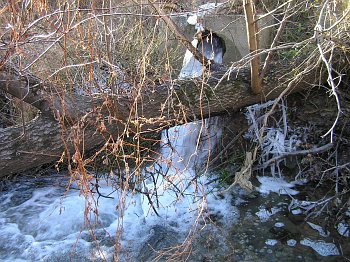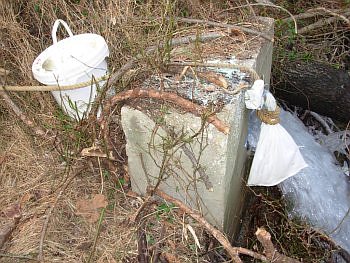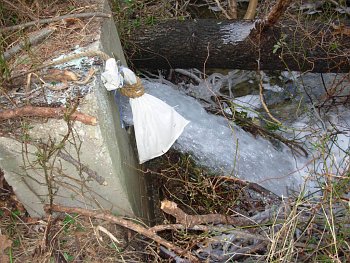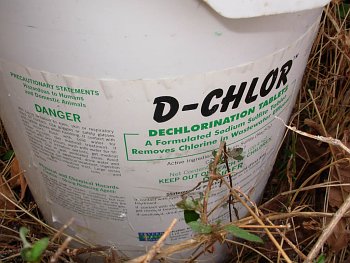


|

|
Chlorinated Water Being Dumped into Sligo |

 Neighbors discovered the torrent on Saturday morning and immediately reported it. WSSC staff did come by but simply looked and allowed the torrent of chlorinated water to continue unabated and fully chlorinated. WSSC staff who came by Monday morning at 9:00 put the D-Chlor bag into the waterfall . They said they had left the bucket there because they "didn't think anyone would come by". Between Friday Jan. 6 and Monday Jan. 9 at 10:00, before WSSC turned it off, millions more gallons of chlorinated water entered the Creek. Unfortunately, as part of the pond maintenance activity DEP had underway, flows to the downstream ponds had been diverted, thereby eliminating any possible mitigative effects the pond may have had on the discharge downstream. The high volume water discharge blew out the flow diversions DEP had installed to enable planned pond dredging operations.
Neighbors discovered the torrent on Saturday morning and immediately reported it. WSSC staff did come by but simply looked and allowed the torrent of chlorinated water to continue unabated and fully chlorinated. WSSC staff who came by Monday morning at 9:00 put the D-Chlor bag into the waterfall . They said they had left the bucket there because they "didn't think anyone would come by". Between Friday Jan. 6 and Monday Jan. 9 at 10:00, before WSSC turned it off, millions more gallons of chlorinated water entered the Creek. Unfortunately, as part of the pond maintenance activity DEP had underway, flows to the downstream ponds had been diverted, thereby eliminating any possible mitigative effects the pond may have had on the discharge downstream. The high volume water discharge blew out the flow diversions DEP had installed to enable planned pond dredging operations.
 |
 |
| Photos by Doree Huneven | |
The damage to life in Sligo Creek is also severe according to DEP:
At Monday Jan. 9, 1:00 pm Monitoring staff returned from the field and reported the following impacts on Sligo Creek.
WSSC declined to notify DEP of planned major maintenance work and made no REAL effort to avoid chlorine poisoning of the stream even when informed of it. If a private company or individual had done this the repercussions would have been severe. Not only did WSSC poison the stream but they did so knowingly - declining to dechlorinate or decrease the flow for days even when they were fully aware of the problem.
Chlorinated water, especially in such a huge volume over such a long period of time is highly destructive to life in the Creek and should not be allowed (see information from the county's web site below). Such huge volumes of chlorinated water should go into the sanitary system, onto the ground far from the creek to be infiltrated into the ground water or into some other temporary containment until water can be dechlorinated and the water be released slowly into the creek.
Also the release does not seem to meet the county and state's own guidelines for release of chlorinated water into the environment We don't see why WSSC should not abide by the same guidelines and why it should be allowed to release such huge amounts of chlorinated water over such a long period of time directly into our streams and waterways instead of into the sanitary sewer system or containment area of slow infiltration into the groundwater.
The Montgomery County Web site states:
Chlorine and other chemicals used in maintaining pools and spas, which often include acidic or alkaline cleaning compounds, can have a severe negative impact on the plant and aquatic life in our streams.
Even at extremely low levels, chlorine can be toxic to aquatic life. Because all streams in Montgomery County discharge to rivers that drain to the Chesapeake Bay, pollution in our local streams and rivers impacts the health and vitality of the Bay. Water pollution in our streams can also affect drinking water supply, as most County residents are served by water drawn from the Potomac River, which is fed by local streams.
Do You Own, Operate, or Maintain a Swimming Pool or Spa?
If so, you must be aware of guidelines to be followed in maintaining and draining any swimming pool. For community pools in areas served by the WSSC sanitary sewer system, pool water should discharge to the sanitary sewer. Water must not be discharged to a storm drain without a permit from the Maryland Department of the Environment (MDE).The Montgomery County Water Quality Ordinance provides for the issuance of$500 civil citations for discharging without a permit or in excess of the conditions specified on the permit.
For residential pools, backwash water should be discharged to the sanitary sewer. (All discharges to sanitary sewers must comply with WSSC requirements.) If your only option in draining pool water is to discharge directly into the environment, water being discharged must comply with the State of Maryland Water Quality Criteria, contained in the Code of Maryland Regulations (COMAR). Maryland Department of the Environment (MDE) is drafting a swimming pool discharge permit that will be issued in the near future; the state permit will includethe conditions outlined below.
Pool water must sit for at least two days (48 hours) after the addition of chlorine, or until chlorine level is below 0.1 milligrams/liter. Chlorine can be tested using a standard pool chlorine test kit. Bromine can have the same impacts on aquatic life and should be handled in the same manner. Maryland State law prohibits the discharge of chlorine or chlorine products into waters of the state that exceed this level.
The pH of the pool water, which is a measure of acidity, must not be less than6.5 nor greater than 8.5 prior to or during discharge. Cleaning fluids and compounds, such as muriatic acid, which is toxic to aquatic life, can depress pH and must be neutralized before being discharged. Algicide, used to eliminate algae in pool water, can severely interrupt normal algal and plant growth in our streams. As such, use of algicide containing metals, such as copper or silver, is discouraged. Total suspended solids, which is a measure of visible matter suspended in solution, must be below 60 milligrams/liter. To achieve this level of clarity in pool water, allow suspended visible particles to settle out, so that v water does not appear murky or cloudy.
If discharging into the environment is your only option, direct the flow onto the land surface, since absorption into the ground offers some opportunity for chemical pollutants to react with the soil, thereby filtering the water. Allow the discharge to flow slowly over the land surface to provide an opportunity to reduce water quality impacts. Overland discharge should meet the conditions outlined above, since these chemicals also harm grass and plants. In addition, minimize temporary flooding and erosion when draining a pool or spa by discharging water gradually. You must control the water flow across your property so as to avoid erosion and a nuisance condition for neighboring properties.